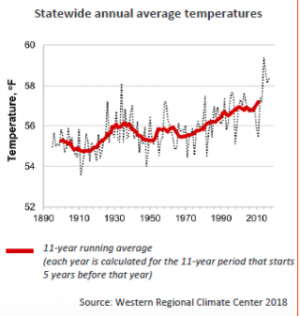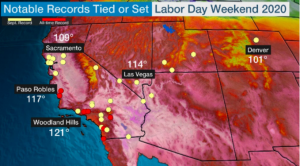Labor Day Heat Wave: Sign of Intensifying Climate Change
As a record-breaking heat wave swept through Southern California on Labor Day weekend, bringing intense forest fire conditions with it; the worsening climate change problem is becoming more apparent and is greatly exacerbated by the fossil fuel industry.
Many believe these heat-related problems to be caused by global warming. Global warming, or climate change, is the increase in atmospheric temperature at an unnatural rate. Greenhouse gas emissions and fossil fuels, such as coal, gas, and oil, become trapped in the atmosphere when they are burned, keeping its heat within Earth’s climate and surface. Global warming, worsened by the excessive use of fossil fuels, is the main cause of the intense heat waves California residents have been experiencing, bringing temperatures to the hundreds.
The extreme heat has begun to affect the students of Mt. SAC ECA. West Covina, California, the city that Mt. SAC ECA inhabits, reached 115 degrees Fahrenheit during the Labor Day weekend (Sept. 5-7), merely 2 degrees below its highest temperature recorded since 1895, when climate records were accurately recorded. This heat wave also brought a worrying record-breaker: Los Angeles County, located in California, reached 121 degrees on September 6, its highest recorded temperature since 1895. Although temperatures are steadily declining as sea breezes become stronger and areas of high pressure move away from California, one main concern remains: future heat waves, influenced by climate change, that will only become more severe.
Hafsa Shafiq, junior from Mt. SAC ECA, expressed her dismay regarding LA County reaching 121 degrees Fahrenheit: “I do find that very shocking. In my area, it usually stays below 90 degrees during this time,” Hafsa stated. This change in temperature is very jarring, though scientists have acknowledged its shift throughout the climate’s history.

The clouds of ash and smoke had traveled upwards ten miles and covered almost the entire south of the state, which is something that had never been seen before. “Hearing about ash falling and seeing the sun and sky red for so long was something I had never seen before. It really felt like the end of the world,” said Kayla Ngyuen, a Mt. SAC ECA freshman.
Mt. SAC ECA’s biology and chemistry teacher Ms. Banh was asked about one aspect of the fire that she hasn’t ever seen before, “Primarily the size and duration of the fire, as well as the number of acres burned, almost 400,000!!” The smoke that the fire has let out caused a grey sky all over Southern California.
The lack of humidity due to this was one of the biggest challenges that the firefighters had to face. The air quality caused the aircrafts to be grounded, some people felt irritation in their eyes, plus the amount of smoke and fog could have easily been a safety hazard on the road. It had also rained ash in certain areas, even in areas that are nowhere near the fires. While the fire has already been contained, the effect it had on the air and the temperature will take a huge toll on us later on.
Historically speaking, global temperatures have increased greatly in the recent past. Temperatures began to be recorded globally during the late 1800s; that is, scientists were able to create estimates for the average temperatures everywhere on the planet beginning in 1880. Some scientists, however, use data from 1895 to have a more accurate set of data in California. According to the California Office of Environmental Health Hazard Assessment (OEHHA), the “annual mean temperatures averaged over [California] have increased by about 1.8 degrees Fahrenheit (°F) since 1895” (OEHHA). Although the amount of change in degrees may seem minuscule, it takes an immense displacement of heat to alter an entire state’s, and ultimately the globe’s, climate by such an amount. Experts from the National Oceanic and Atmospheric Administration (NOAA) support this in their 2020 report by stating, “Given the size and tremendous heat capacity of the global oceans, it takes a massive amount of heat energy to raise Earth’s average yearly surface temperature even a small amount,” (NOAA).
Labor Day weekend’s record-breaking heat wave shows that climate change’s effects are slowly becoming more powerful; heat waves are more frequent and amplifying in temperature. This is caused by a large number of fossil fuels used in the United States. According to the U.S. Energy Information Administration (EIA), about 88% of the United States’ energy sources are non-renewable sources of energy or fossil fuels, a study from 2019 showed (EIA).
Heat waves, especially ones as intense as the one during Labor Day weekend, also bring conditions that enable fires to thrive and lay siege to forests; this explains the dramatic intensity and severity of fires currently burning throughout California, such as the Bear Fire, Bobcat Fire, El Dorado Fire, and August Complex Fires. This caused orange skies, a light fall of ash, and a smoky smell to become part of California residents’ lives outside their homes.
Your donation will support the student journalists of Mt. SAC Early College Academy. Your contribution will allow us to purchase equipment and cover our annual website hosting costs.

Jordan Alvarado is in his senior year and this is his 2nd year on the Academy Chronicle staff. They are the secretary of the UNICEF club and are a part...
Elisabeth is a Mt. SAC ECA freshman, this is her first year being a part of the Academy Chronicle Staff. Elisabeth has been excited for House competitions...









